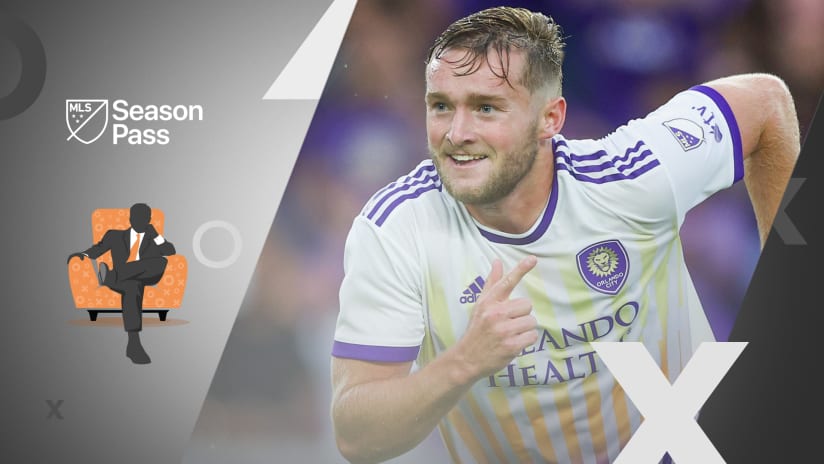And down the stretch they come. As usual, all data in this column is from TruMedia via StatsPerform unless otherwise noted.
In we go:
Columbus Crew vs. Philadelphia Union
- WATCH: Apple TV - MLS Season Pass | Saturday, 7:30 pm ET
Even after a rough trip to Dallas, the Crew remain No. 1 in possession and top five in virtually every attacking metric – expected goals, expected assists, box entries, shots on target, xG per shot, etc., etc.
The Union have a different game model, though like Columbus, they’re generally near the top of most attacking metrics. And they’re still mostly the same Philly team that nearly did the double last year.
So why does it feel so different? Check out that shot-stopping number from Andre Blake, from our friends at American Soccer Analysis:

He was other-worldly the past two years. This year he’s merely been very good.
Inter Miami CF vs. New York City FC
- WATCH: Apple TV - MLS Season Pass | Saturday, 7:30 pm ET
Passing sequences start deeper without Lionel Messi and they get shots from possessions that start closer to goal a lot more with Messi on the field. Look at these graphics from TruMedia via StatsPerform:
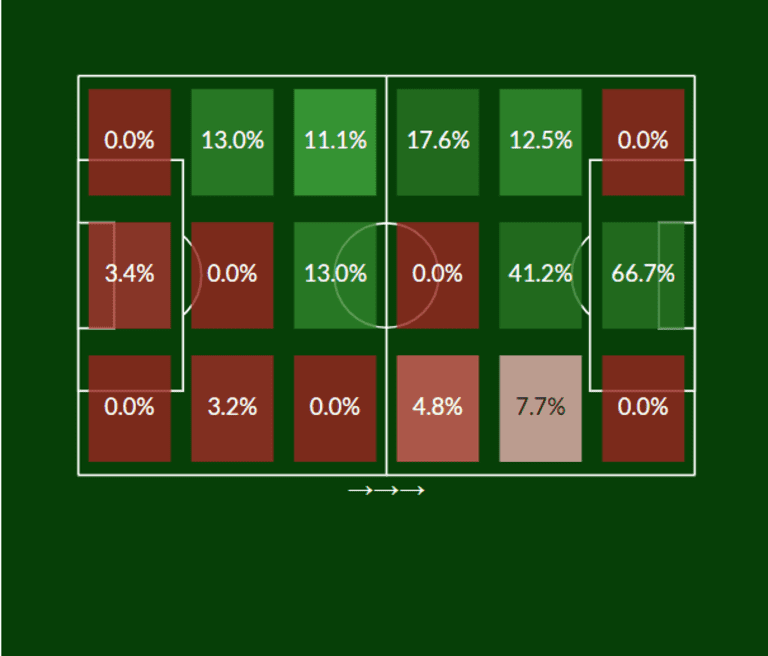
That’s with Messi on the field under Tata Martino. Here’s what it looks like without him:
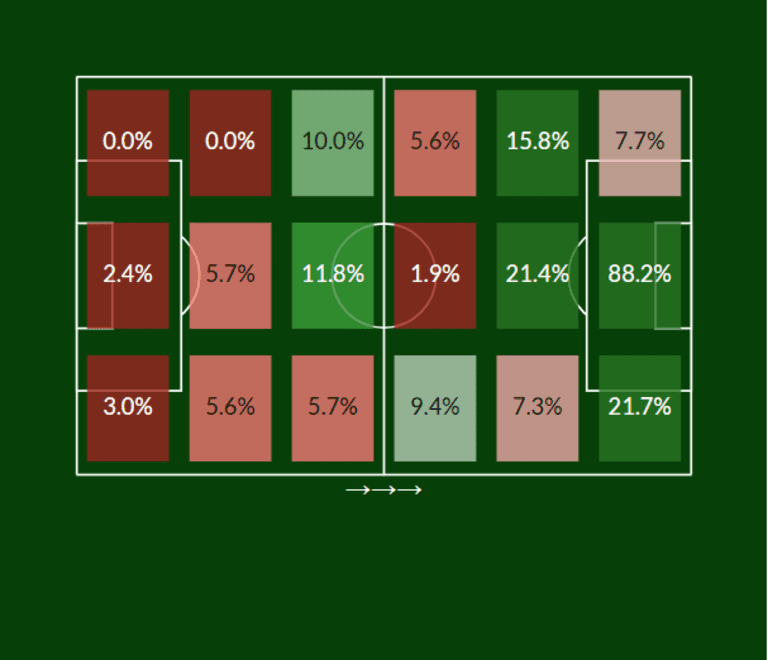
So yeah, even though he doesn’t defend much, Miami actually become a more aggressive pressing team with him out there.
NYCFC, who are among the league leaders in passes played in their own defensive third, will have to prepare for both eventualities this weekend.
New England Revolution vs. Charlotte FC
- WATCH: Apple TV - MLS Season Pass | Saturday, 7:30 pm ET
Here is the Revs’ network passing graph from their 2-2 draw at Chicago last weekend, the one in which interim head coach Clint Peay debuted his new tactical approach with left back Matt Polster tucking into the midfield in possession:
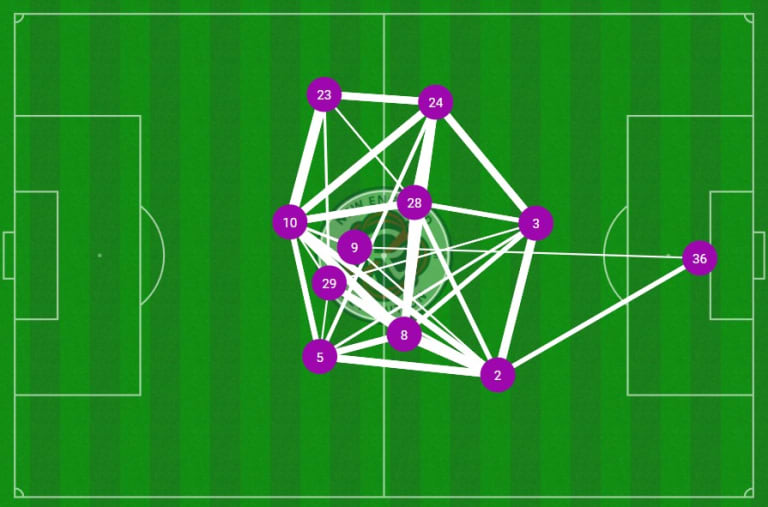
Can see it plain as day.
Christian Lattanzio tried to do something similar earlier this year, with Brandt Bronico starting at left back and then tucking inside. It didn’t work, so over the course of the season he’s switched to having one of his CBs – usually rookie Andrew Privett – step into midfield while the other CB and both fullbacks from a more static back three.
That’s been fun to watch, but it also hasn’t really worked as Charlotte have conceded 48 goals. That’s worst in the East.
New York Red Bulls vs. Chicago Fire FC
- WATCH: Apple TV - Free | Saturday, 7:30 pm ET
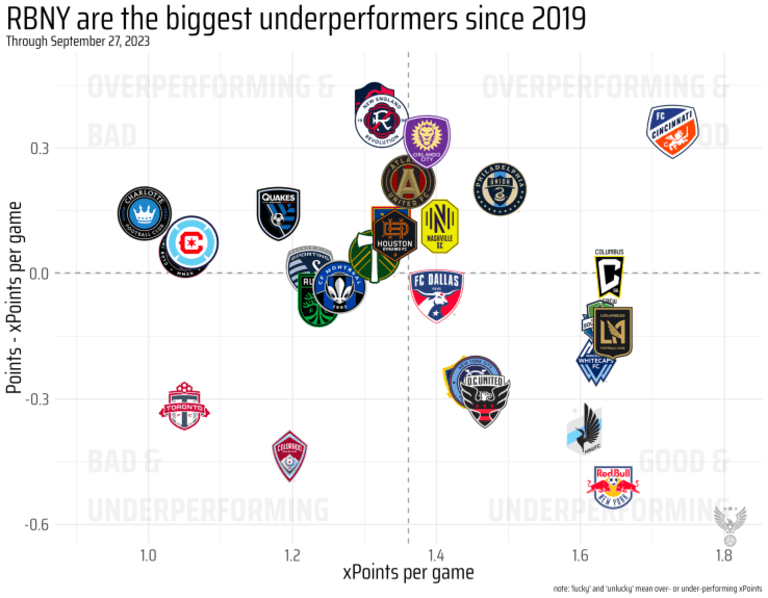
So look, I don’t love the game model – I think it’s ugly to watch. But it still works.
What hasn’t worked is the recruitment, as the front office has still not found adequate replacements for the MLS 360 guys.
You can see from that graphic the Fire are right where they’re supposed to be, by the way. Seems like an organizational reset is all but guaranteed this offseason, though the wild thing is if they win this one and the other results break their way, they’ll be back above the red line entering October.
Orlando City SC vs. CF Montréal
- WATCH: Apple TV - MLS Season Pass | Saturday, 7:30 pm ET
Duncan McGuire celebrated his return to the starting XI with a poacher’s goal in last week’s 1-1 draw with Miami. He’s significantly overperforming his xG:
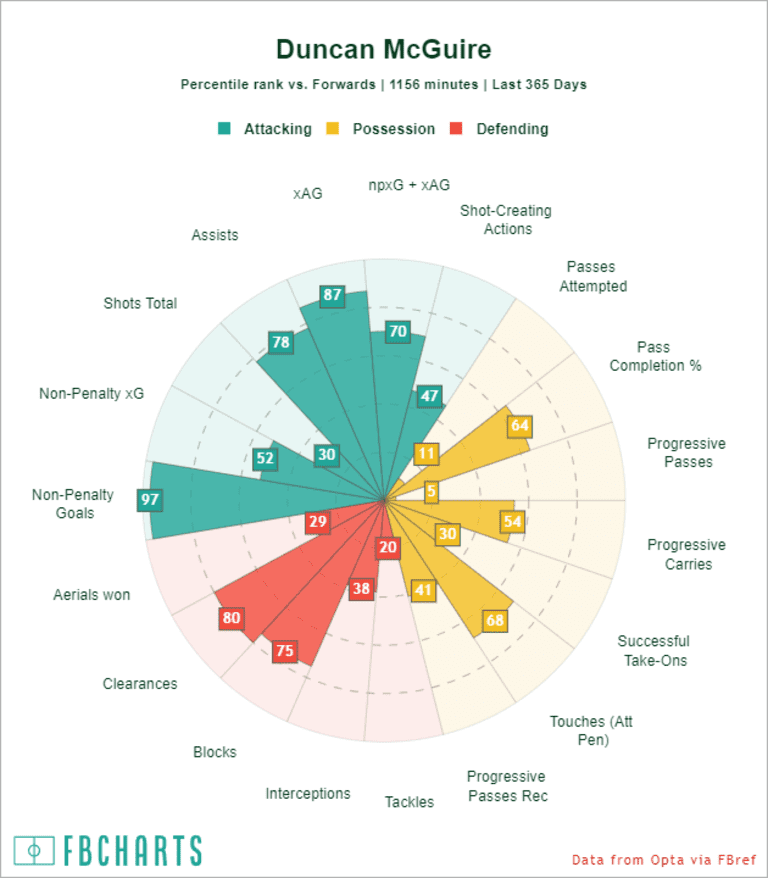
Notice his xAG (expected assists) in that wheel, though. He’s in the 87th percentile, which speaks to his elite feel around the box and in transition. This one right here… this is not typical play from a 22-year-old in his first season as a pro:
Montréal also have two young forwards, in Kwadwo Opoku and Jules-Anthony Vilsaint, who I am really high on. Both, however, are more notable for their defensive work than their in-the-box acumen.
Toronto FC vs. FC Cincinnati
- WATCH: Apple TV - Free | Saturday, 7:30 pm ET
Worst vs. first.
If there is one advanced stat that sums up TFC’s futility, it’s ASA’s “receiving G+,” which is a stat that measures the value of each pass based on the location of the player receiving the pass. The Reds are dead last by a pretty decent chunk, which means they’re not getting their attackers into good spots with any regularity.
Cincy’s superpower is they lock down those exact parts of the pitch, and are third in receiving G+ allowed. You can actually complete valuable passes through the midfield against them, but once you get into the final third you’ll get nothing and like it.
Houston Dynamo FC vs. FC Dallas
- WATCH: Apple TV - MLS Season Pass | Saturday, 8:30 pm ET
I recently described Houston’s overall approach to a friend as “pretty wild, but I think it's more vibes than tactics.” And so it was gratifying to see Héctor Herrera give this quote to The Athletic:
There is nothing in the numbers that really distinguishes Houston one way or the other. If you want to really dig, you could say they complete more passes from their own defensive third than the vast majority of teams, yet conversely they complete proportionally fewer progressive passes of 10 yards or more. Which basically means they knock it around until they see an opening, and then they go.
Dallas are trying to become that team as well, and shifting to a 4-2-3-1 with Alan Velasco as a No. 10 should help.
Minnesota United FC vs. San Jose Earthquakes
- WATCH: Apple TV - Free | Saturday, 8:30 pm ET
You can see in the graphic above that Minnesota are in RBNY’s neighborhood on the good/lucky – or in their case, unlucky – axis. Thus far the Loons have underperformed their expected goal differential by 13.5 goals as per American Soccer Analysis, which is third-worst in the league behind Colorado and, of course, the Red Bulls.
San Jose have actually overperformed by 3.58, which puts them comfortably into the top half of the table by that stat. But that’s because of Daniel, their superb No. 1 goalkeeper (and JT Marcinkowski, it should be noted, was really good earlier this year when Daniel was hurt). Their attack is both underperforming their underlying numbers and generating fewer clear-cut chances than they managed last season.
Nashville SC vs. Seattle Sounders FC
- WATCH: Apple TV - MLS Season Pass | Saturday, 8:30 pm ET
The Sounders, all year long, have leaned into the idea of pitch control. And so they’re among the league leaders in possession, passes per sequence, passes into the final third and progressive passes. By and large, the game takes place on the field where Seattle want it to take place. They just haven’t finished.
Nashville are still entirely happy to concede the ball to opponents, even at home. They often sacrifice both possession and field position for space to counterattack into, as evidenced by the fact they are dead last in the league in field tilt (i.e., share of final-third passes hit per game).
St. Louis CITY SC vs. Sporting Kansas City
- WATCH: Apple TV - Free | Saturday, 8:30 pm ET
A clash of styles in this one, as Sporting KC will play a wide 4-3-3 and try to control the game with the ball, while St. Louis alternate between a mid-block counter and a high press, and always being ruthlessly direct no matter what.
The numbers: St. Louis have the fastest direct speed in the league (1.83 meters/second), while Sporting are third-slowest (1.19 m/s). Sporting hit the sixth-most passes per sequence (3.7) while City hit the 28th-most (2.5).
Colorado Rapids vs. Austin FC
- WATCH: Apple TV - Free | Saturday, 9:30 pm ET
Cole Bassett’s got two goals and an assist in his past three games, plus looks to be playing with real freedom for the first time all year. The sample size is small, but he’s completed nearly 75% of his passes into the penalty area since the coaching change. Prior to the change, he was down below 50%.
Austin are still waaay too reliant on crossing the ball. They lead the league in cross ratio – the percentage of open-play passes into the box that are crosses – by a mile, at 46.7%. No one else is over 42.5%
LA Galaxy vs. Portland Timbers
- WATCH: Apple TV - MLS Season Pass | Saturday, 10:30 pm ET
Speaking of total cross ratio, the Galaxy have done a good job of becoming less reliant on crosses over the past few months. Their TCR was 39.2% from February to mid-June. It’s dropped to 33.6% since then, which speaks to their new-found patience and improved final-third patterns of play.
Moving Santi Moreno inside, as a free 8 in a 4-3-3, has unleashed him as a ball-progressing terror off the dribble. He hadn’t offered much of that as a winger under Gio Savarese.
Vancouver Whitecaps FC vs. D.C. United
- WATCH: Apple TV - MLS Season Pass | Saturday, 10:30 pm ET
Moving Ryan Gauld up top alongside Brian White in a 3-5-2 back in mid-July was a masterstroke from ‘Caps head coach Vanni Sartini. In league play only (nine games) Gauld’s got 5g/5a while White has 6g/2a, and the underlying numbers say Gauld’s been the second-best passer of the ball in the league since then (using ASA’s G+ model) and White is receiving the most valuable passes by far.
D.C.’s Christian Benteke is sixth in pass reception numbers. D.C. just don’t have a creator of Gauld’s caliber.
LAFC vs. Real Salt Lake
- WATCH: Apple TV - Free, FS1 | Sunday, 8 pm ET
LAFC signed a No. 9 during the summer window (Mario González) but still mostly aren’t using him. And so we’ve got nearly a full season’s worth of data without a true center forward, which shows up in one particular stat: shot distance.
In 2022, with Chicho Arango as the starter, LAFC’s average shot distance was 16.1 yards, which was good for ninth in the league. This year they’re 24th, at 17.4 yards.
RSL, even with Chicho, are dead last at 18.5 yards. That’s just a wild lack of final-third discipline from a team that usually starts two true forwards.


